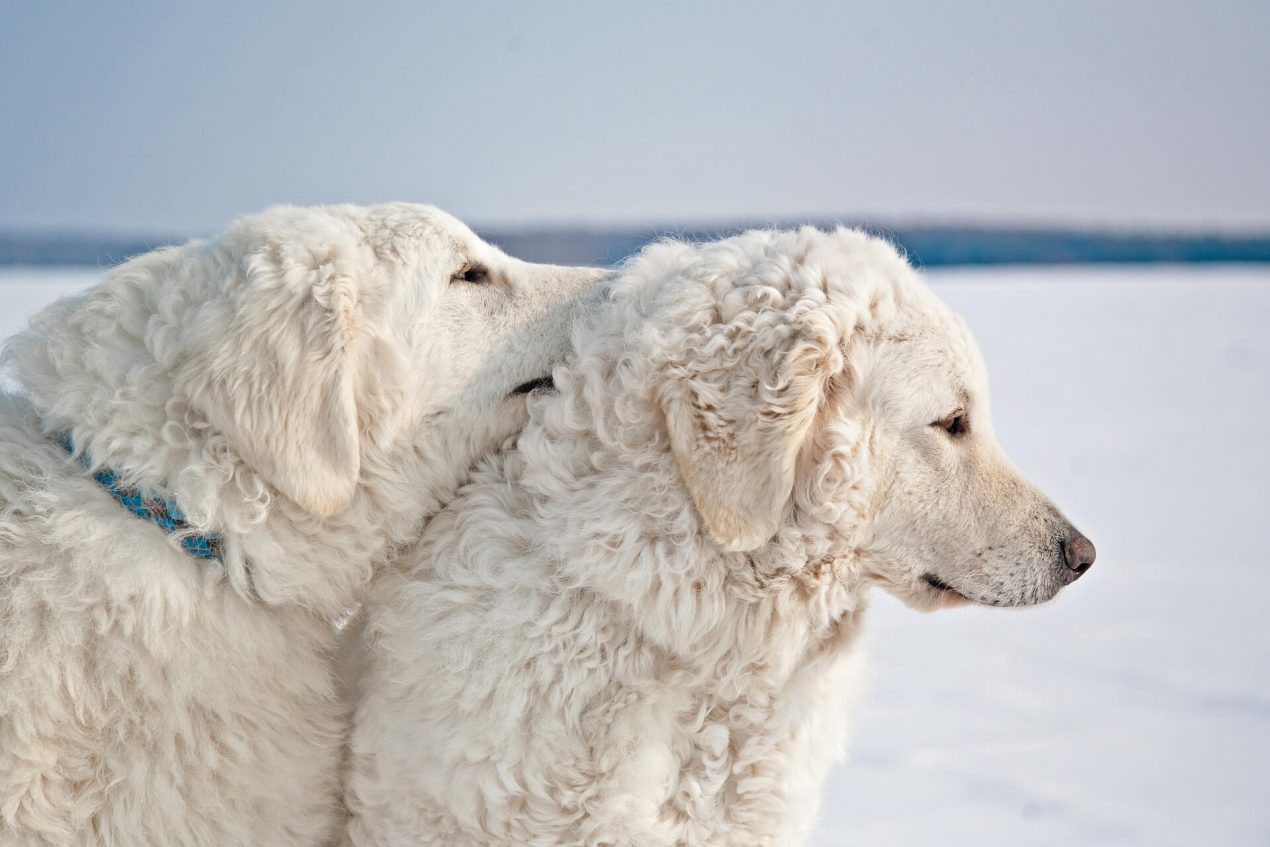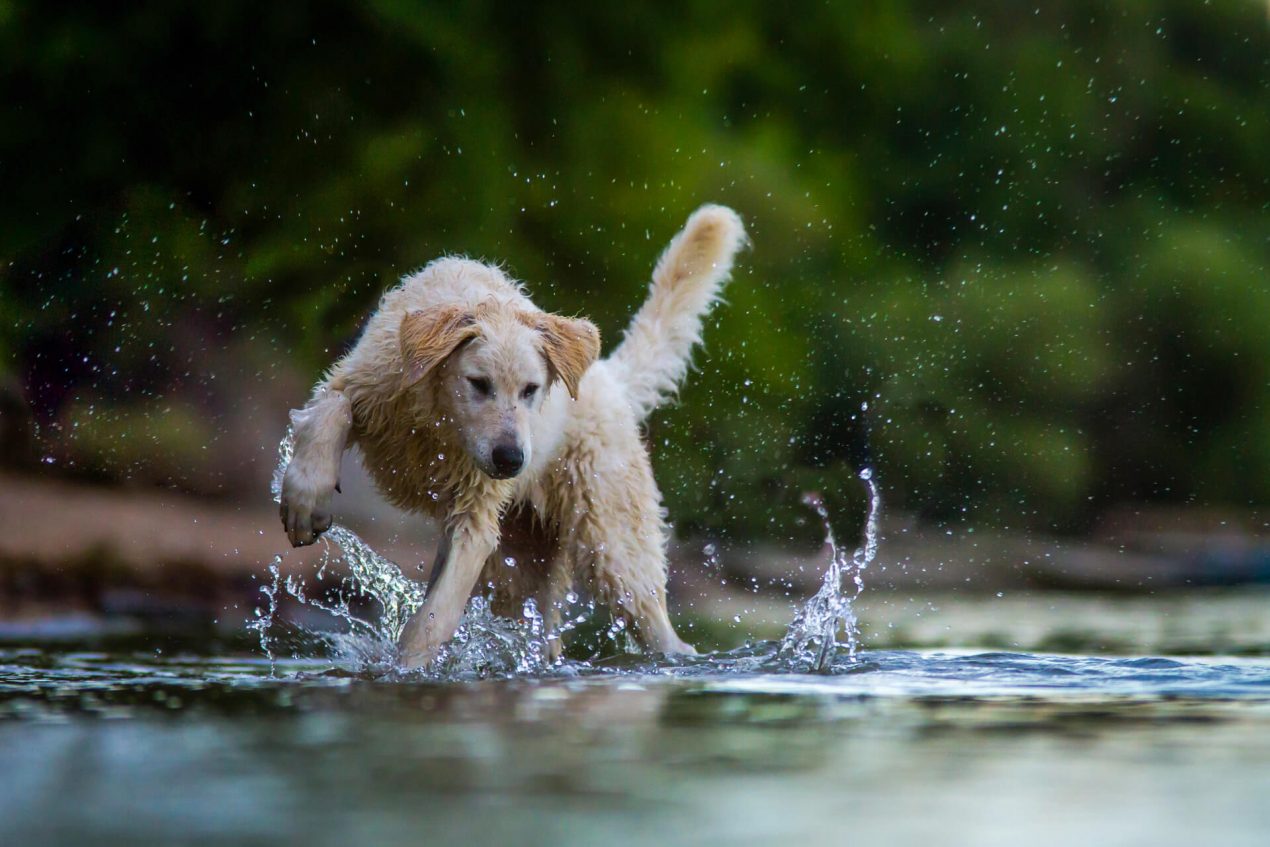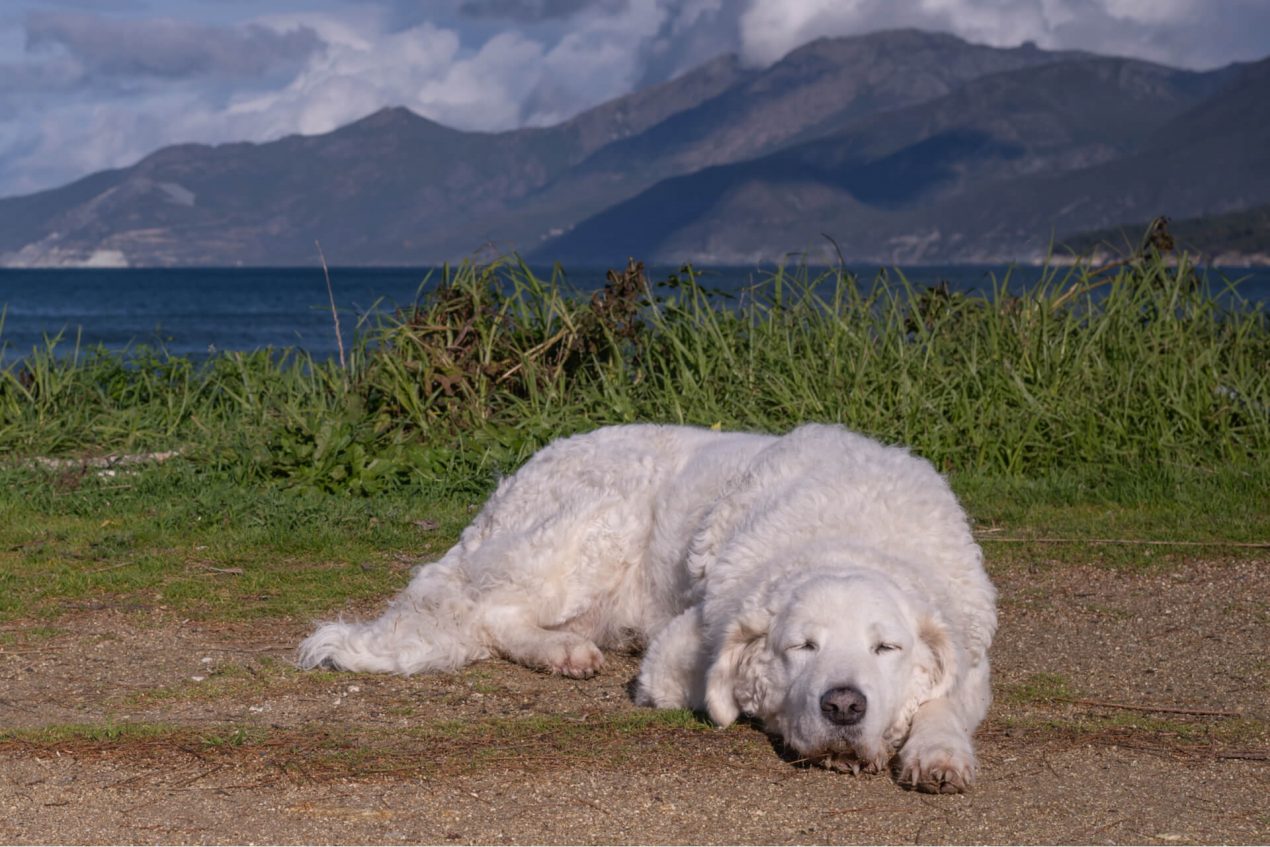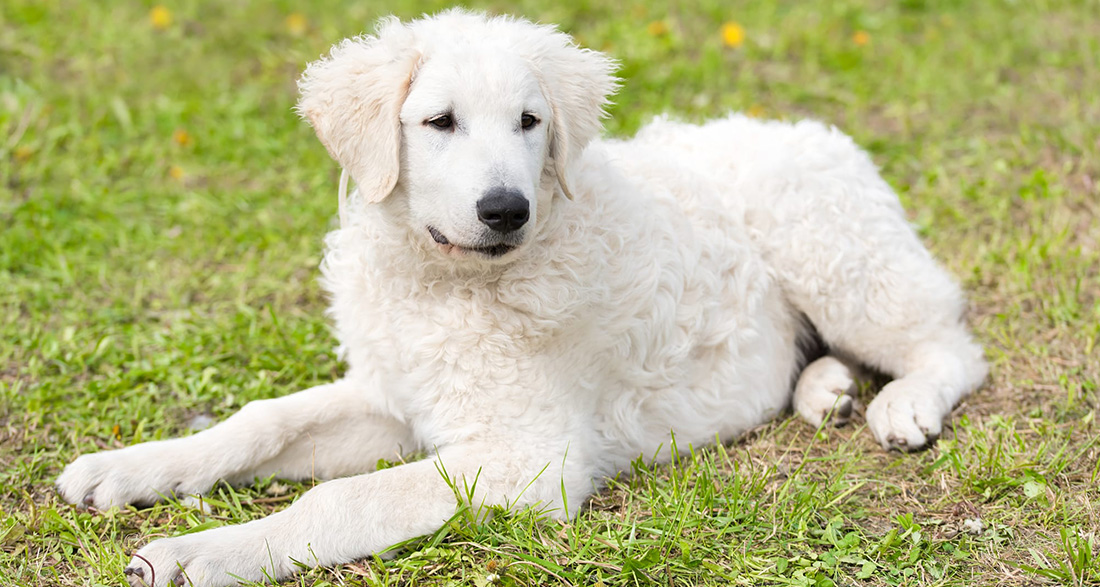The Kuvasz is a Hungarian livestock guardian dog that may not be suitable for everyone. Experienced dog owners, however, will find much joy with this white, somewhat independent giant.
History of the Kuvasz
Originally, the large, elegant livestock guardian dog was particularly common in Hungary, where it was bred and kept. It was primarily used for herding and guarding sheep flocks, as well as other livestock herds. It had to protect the animals not only from natural enemies like wolves and bears but also from thieves, which is why the breed inherently distrusts strangers. Additionally, due to its strong bite force, fearless nature, and independent thinking and working style, the large quadruped was also often kept as a guard dog for large estates and properties.
For a long time, livestock guardian dogs were not divided into separate breeds but were seen as a unit. Therefore, there were often crosses between the Kuvasz and the second well-known Hungarian shepherd dog, the Komondor. Today, the Komondor is best known for its shaggy coat, which almost looks like the dog has dreadlocks.
It wasn’t until 1905 that the two breeds were separated and each received its own breed standard. Wealthy city dwellers soon discovered the Kuvasz as a prestigious, noble companion in everyday life—a reason why this breed seems to be somewhat better adapted to modern life than other livestock guardian dogs.
Today, there are three associations in the AKC (American Kennel Club) dedicated to the breeding and keeping of the Kuvasz. Between 50 and 100 puppies of this breed are born in the United States each year—a seemingly small number at first. However, it must be considered that the Kuvasz is not a dog for everyone, and only very experienced dog owners should venture into keeping them.
Breed Overview
GROUP: Working
HEIGHT: 28 to 30 inches (males); 26 to 28 inches (females)
WEIGHT: 100 to 115 pounds (males); 70 to 90 pounds (females)
COAT: Thick, medium-length double coat; Ranges from straight to wavy
COAT COLOR: Solid white
LIFE SPAN: 10 to 12 years
TEMPERAMENT: Protective, loyal, calm, intelligent, affectionate
HYPOALLERGENIC: No
ORIGIN: Hungary
Character and Temperament
The Kuvasz is a true livestock guardian dog—but what does that mean? First and foremost, it had to think and act very independently for its original tasks; dogs that only blindly follow commands would be useless for protecting the herd, especially at night.
In addition, it required a strong, fearless, and courageous character, as well as great adaptability, to thrive in the sheep flock. For defense against physically superior predators like bears, the Kuvasz also needed a low threshold for aggression and a certain potential for aggression: fearful dogs that run away from enemies instead of fighting would be immediately discarded by herd owners.
All these qualities, taken individually, sound very positive—but precisely because of them, the Kuvasz is neither a dog for inexperienced beginners nor a typical family pet. In everyday life, its independent thinking can quickly become a problem if the owner lacks consistency and perseverance—then the dog will simply do as it pleases. Combined with its underlying readiness for violence and distrust of strangers, this can quickly become an explosive, very unhealthy mix!
However, with consistent but loving guidance from an experienced owner, the Kuvasz can be an extremely loyal, pleasant companion.
| Affection Level | High |
| Friendliness | Medium |
| Kid-Friendly | High |
| Pet-Friendly | Medium |
| Exercise Needs | Medium |
| Playfulness | Medium |
| Energy Level | Medium |
| Trainability | Medium |
| Intelligence | High |
| Tendency to Bark | Medium |
| Amount of Shedding | High |

Acquisition of a Kuvasz
Before acquiring a dog of this rather special breed, several questions need to be considered. In addition to the fundamental requirements – such as having a property, sufficient time, financial means for feeding, and medical care for such a large animal – the prospective owner must also consider other aspects. Above all, they should honestly question whether they have enough experience and assertiveness to handle such a four-legged companion. If even the slightest doubts arise with this question, it is advisable to look for another, more suitable breed.
What should I pay attention to when buying?
As with all other breeds, it is also important with the Kuvasz to visit the breeder several times and question essential things before making a final purchase decision. In addition to the breeder’s expertise, cleanliness of the facility, and the health of the parent animals, optimal socialization plays a particularly important role with this breed:
Especially with livestock guardian dogs, it must be ensured that the puppies are accustomed to, among other things, being house-trained, playing with parents and siblings, getting used to everyday noises and situations, and having contact with as many different, unknown people as possible. This can help to somewhat reduce their natural distrust of strangers, which can be extremely helpful later in life.
Responsible breeders of this breed will thoroughly scrutinize the prospective buyer to assess their suitability for a livestock guardian dog. They know the breed inside out and understand that it is not well-placed in the wrong hands and can cause great harm. Honesty is a must here: Pretending to the breeder and then being unable to meet the dog’s needs helps no one. If the worst does happen, many breeders will take the dog back and try to rehome it – but it’s better if that’s not necessary in the first place.

Development and Training of the Puppy
Kuvasz puppies look like plush, very cute, clumsy little teddy bears. One must not be deceived by this impression – they quickly become very active bundles of energy, full of curiosity and mischief, exploring their surroundings. Things can sometimes break, as with so much strength and size, which also keeps increasing, one must learn to handle it!
Physical violence or pressure in response to small mishaps of this kind or even with house training is not constructive. It is better to react consistently but lovingly. As with all dog breeds, good behavior is extensively praised, while bad behavior is ignored as much as possible. In this way, the little four-legged friends understand much more quickly what is expected of them; moreover, they will quickly build a strong bond with their caregiver.
It is also extremely important to accustom a Kuvasz puppy early on to the fact that all family members must be accepted and that guests and other visitors, such as mail carriers, etc., must not be threatened. However, the property should still be secured in such a way that the dog does not have to decide whether the entrant is a burglar or harmless. Either assign them their own, fenced-off area, or place the doorbell on the outermost perimeter.
How to Keep a Kuvasz?
If you have no experience with dogs, especially livestock guardian dogs, it’s best not to get one at all! The Kuvasz is definitely not a dog for beginners. Due to its independent way of working and its inherent distrust of strangers, which is strongly pronounced in all livestock guardian dogs, this dog requires a lot of experience and consistent but loving leadership.
However, in the right hands, the Kuvasz can be a real treasure – then it is also well suited as a family dog.
Members of the breed prefer to be outdoors: This is largely due to their strong desire for independence, but of course also to their thick fur, which quickly becomes too warm for them indoors. For many of these dogs, there is therefore no punishment if they are moved outside onto the property – of course with a correspondingly comfortable shelter and possibly a companion as company.
Here the Kuvasz feels comfortable because here it can pursue one of its original tasks: guarding the property. As mentioned above, the safety of guests and other strangers must always be ensured: The fence must be secured in such a way that the Kuvasz cannot escape even when fully grown, and visitors must have the opportunity to make themselves known without having to enter the property.
Activities with the Kuvasz
This breed is known for its calm, composed nature. Although many of the dogs remain very playful well into old age and also enjoy romping around with “their” humans, most Kuvasz are not enthusiastic about dog sports and other antics on command. They are content to guard their property, go for walks with their owner, and otherwise participate in everyday family life.
However, the property to be guarded is almost indispensable – in a city apartment and with the spatial constraints of urban life in general, this breed does not cope well. They need space to move around, and in the city, there are far too many unknown people gathered in close quarters for a livestock guardian dog – this makes them nervous, and in the worst case, they become aggressive.

Health and Grooming
The Kuvasz is a very low-maintenance dog: occasional brushing is completely sufficient for them. Bathing is not only unnecessary, but it also destroys the skin’s natural protective barrier and should therefore be avoided at all costs!
Furthermore, the breed is very old and primitive – therefore, these dogs are particularly robust and not susceptible to diseases. Allergies also occur only in rare cases. Nevertheless, the food – as with all breeds – should consist mainly of meat and contain as little grain as possible. Snacks made from dried meat and/or dried animal hides can be given for dental care. They also serve to relax and entertain the four-legged friend.
Interesting and Worth Knowing
The Kuvasz is closely related to the Hungarian Komondor but, unlike the latter’s shaggy mane, has a medium-length, smooth coat. Like almost all dogs used primarily for herding and protecting sheep, it is almost exclusively found with white fur.
Do you also have a Kuvasz or are you considering getting one? Tell us in the comments what makes the breed so special in your opinion!


